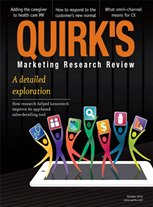This issue's keywords: loyalty; mobile marketing; digital natives; social media; CTRs
Redwood City, Calif. researcher StrongView’s 2014 Brand Loyalty Survey found that age and higher income had little relevance to a consumer becoming a loyal customer, with loyalty being largely equal across all 18-to-54 age brackets and 67 percent of loyal customers having income of $75,000 or less annually. The most loyal customers, called Brand Enthusiasts by StrongView, were found to be more valuable than new customers in that they spend an average 13 percent more than other customers and are three times more likely to purchase the brand frequently. The survey polled more than 2,200 online U.S. adults from March to April 2014 and was conducted in conjunction with Edison Research, New York.
Researchers have found that commuters in crowded subways are twice as likely to respond to targeted promotions on their mobile phones as those in non-crowded subways. Anindya Ghose of NYU Tern Center for Business Analytics, Michelle Andrews and Xueming Luo of Temple University and Zheng Fang of Sichuan University reported results of their study, which analyzed data gathered from subway riders in a southwestern city in Asia. After measuring the number of commuters in a subway car, they sent targeted SMS message promotions to mobile users. When the train crowd density was fewer than two people per square meter, 2.1 percent of commuters purchased an item from the SMS message, but this increased to 4.3 percent when the train had five people per square meter. The researchers attributed the change in behavior to the commuters becoming more engaged with their mobile devices as the trains get more crowded, leading them to respond more often to targeted messages.
The TGI Clickstream report from Kantar Media indicates that age is not the best predictor of digital behavior, with “digital natives” who grew up with technology (15-24-year-olds) being no more likely than other age groups to take part in a variety of digital behaviors, such as paying to download an app. Thirty percent of this age group reported this behavior, the same percentage as 35-44-year-olds. The Clickstream analysis found that the best predictor of behavior was the consumer’s level of knowledge acquired through education and general cultural experiences, called “social DNA” by Clickstream. Adults aged 35-64 with high social DNA were 65 percent more likely to purchase travel online and were 52 percent more likely to buy music or videos online than the average Internet user.
A U.K. poll found that 79 percent of B2B marketers surveyed see social media as the most effective digital marketing channel and 38 percent said they would spend extra advertising funds on social media. At the same time, only 16 percent of the 115 marketers were confident in the ROI measurement from social media. The research was completed by Cambridge, U.K., advertising agency, Omobono, with Circle Research, London, and the Marketing Society, Twickenham, U.K.
Researchers reported in the Journal of Marketing Research that social media data can be used as leading indicators of brand health. The researchers developed a model designed to determine consumer attitudes about a brand from social media comments. The social media model results were similar to the findings of more expensive and lengthy brand tracking studies.
These reports were compiled from recent issues of the Daily News Queue, a free e-newsletter digest of marketing research and insights news and information delivered each business morning. Not already in the Queue? Sign up here!
